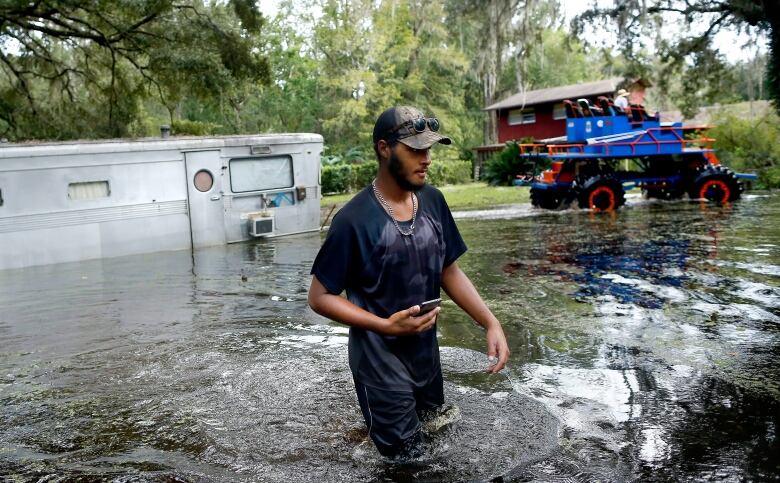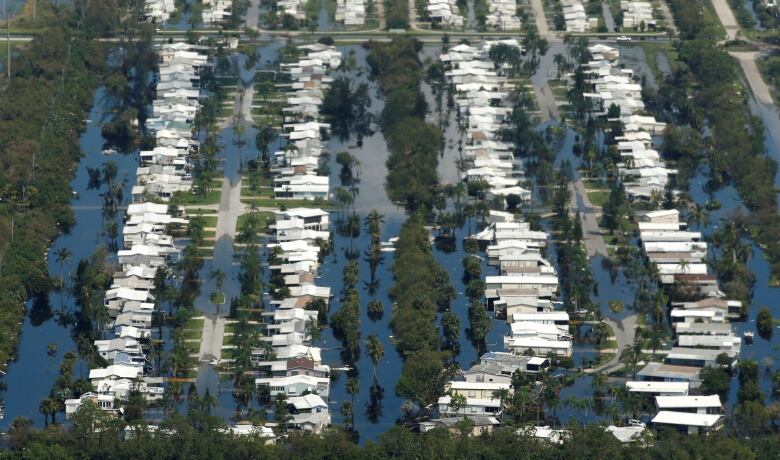Florida switches from search and rescue to 'long recovery' after Irma
Bacteria and agricultural and industrial contaminants from sewage overflows also a big concern

About 1.5 million homes and businesses in Florida and Georgia remained without power on Friday after Hurricane Irma roared through the state.
Federal and state officials said ata news conference that in some areas, getting the power grid back to typical capacity could take days or weeks.
"This is now the hard part. The recoveriesare always difficult. This is going to be a long recovery," said Rick Perry, U.S. secretary of energy.
Two new cases of carbon monoxide poisoning from temporary generators made clear that dangers remained nearly a week after the powerful storm hit.
In Palm Beach County, a woman died and three men were in critical condition after authorities said carbon monoxide seeped in from a generator positioned just outside a home's garage on Thursday.
A family of four was also being treated Friday near Miami for exposure to the dangerous fumes from a generator outside their apartment.

Protecting elderly residents
The state has also made urgent efforts to protect its vulnerable elderly residents after a string of deaths at a nursing home.
"They're more susceptible to the heat," Broward County commissioner Nan Rich said of the need to protect seniors.
"The thing that hits them first is dehydration, and then their temperature increases and then respiratory issues kick in. Then there's medication that needs to be refrigerated."
On Thursday, 57 residents were moved from a suburban Fort Lauderdale assisted-living facility without power to two nearby centres where electricity was just restored. Workers scrambled to keep patients cool with emergency stocks of ice and Popsicles.
Still, progress was being made. Statewide, only threenursing homes were still waiting for full power Friday night, according to the Florida Health Care Association.
Perry, who served over a decade as governor of hurricane-prone Texas, said the disaster response to Irmahas been the best he's ever seen.
He hailed the efforts from both state and federal workers, as well as workers from 32 states and Canada who answered the call before the hurricane to help with the anticipated problems with the grid.

Acting Secretary of Homeland Security Elaine Duke said the goal now is to return people to their homes "as quickly as safety allows," but that the challenges are great, pointing to contrasts with Hurricane Harvey, which battered Texas and parts of Louisiana just before Irma's arrival.
Duke said the damage in Texas was more localized, while in Florida there have been reports of Irma damage in all 67 counties. As well, wind and not rain was the primary cause, unlike with Harvey.
Massive power outages
"That means homes are demolished, boats have been tossed around like toys, trees have been splintered," she said.
About 1.5 million homes and businesses in Florida and Georgia remained without power on Friday. Nearly 25 per cent of all customers in Miami-Dade County still don't have power.
Florida Power andLight officials earlier this week said that most customers on Florida's east coast would have their electricity restored by Sunday evening. They said it would take until Sept. 22 to get electricity back to the majority of customers in southwest Florida.
Tens of thousands of customers in Pinellas County on the state's west coast still don't have electricity as well.
'It's only Day 4 after Irma'
Brock Long, administrator of the Federal Emergency Management Agency (FEMA), said search and rescue efforts are wrapping up and now the challenge is to get affected residents on the road to recovery.
He estimated about 10,000 remain in shelters from a peak of 200,000 last week.
"We have a long way to go. It's only Day 4 after Irma," he said.
Long said finding transitional housing will require "innovative solutions," with officials aware of the shortage of trailers, and the issues in the past with trailers and cruise ships used after storms.
The ships seem to have been ruled out for all but "intermittent" shelter needs, such as for the emergency response workers who have been helping in the disaster recovery effort.

The power issues zap air conditioning and refrigeration and also cause another dangerous headache: sewage overflows.
Local governments have submitted well over 100 "notices of pollution" to the state Department of Environmental Protection since Hurricane Irma struck, some involving multiple spills and releases of millions of litres of wastewater in various stages of treatment.
"Floodwaters may contain not only bacteria from sanitary sewer overflows but other potential contaminants from agricultural or industrial waste," Environmental Protection Department spokespersonDee Ann Miller said.
Nearly 23 million litres of wastewater werereleased from a plant on Virginia Key near Miami during a seven-hour power outage overnight Sunday that disabled its pumps one of seven spills reported by the Miami-Dade County Water and Sewer Department. The water had gone through most of the treatment process but hadn't been chlorinated, spokeswoman Jennifer Messemer-Skold said.
Officials advised people not to swim at Miami-area beaches until waters could be tested for a variety of pollutants.

The U.S. Environmental Protection Agency deployed teams to help state officials assess damage to wastewater and drinking water systems.
Wastewater treatment is challenging enough in a state with flat, low-lying terrain and a booming population concentrated largely in coastal cities. Pipes and other infrastructure are aging and many residents use private septic tanks that are susceptible to flooding.
Too early to know scope of wastewater issue
Electricity interruptions during heavy storms often deliver the knockout punch to already vulnerable systems. They shut down "lift stations" pumping wastewater from lower to higher elevations on its way to treatment plants, causing backups that can propel untreated sewage into homes or through manhole covers onto city streets.
Some lift stations are equipped with emergency generators, while others are idled unless officials can get portable generators to them.
As of Wednesday, the Gulf Coast city of St. Petersburg had reported four spills. The largest, totalling about 1.65 million litresof partially treated wastewater, overflowed from a treatment plant holding tank Monday, while the others were at manholes.

Other systems reported bigger spills including 4.2 million litres of raw and treated sewage from the city of Oviedo and 5.7 million litresof effluent from a facility in Osceola County.
More than 125 systems in about 40 Florida counties advised residents to boil tap water before using it for drinking or cooking.
With files from Reuters and CBC News












_(720p).jpg)


 OFFICIAL HD MUSIC VIDEO.jpg)
.jpg)



























































































